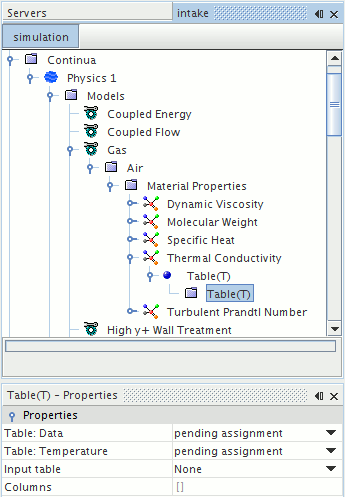Using Table(T)
A (T) table has a column of temperature values and a column of data values.
By default, a linear-piecewise interpolation method is used for interpolating between data points in the table. If the point lies outside the table range, the function value is computed at the nearest data point in the table. The properties for this function are set in the Properties window.

Table (T) Properties
| Table: Data | Identifies the selected column in the table file as the Data (for example, Thermal Conductivity) column. | |
| Table: Temperature | Identifies the selected column in the table file as the Temperature column. | |
| Input Table | Selects a table from among the ones that appear as nodes in the Tables node of the Tools node. | |
| Columns | Displays headings of columns in the table (read-only). | |
Table (T) Expert Properties
| Table Format | Read-only. Reports the format of the table data. Before the data is read and processed, the state is
Unprocessed. Afterward, the state is one of these three:
|
|
| Verbose | Provides more output for this value while the simulation is running. This property can be useful for debugging problems when they occur. | |
| Cubic Interpolation |
When On, provides smoother interpolation between table values than the default linear-piecewise method, and reduces simulation iteration time. This option is supported only for 1D and 2D Cartesian and Structured tables, as described in the Table Format property. This requires relatively smooth data to produce reliable results. For sudden jumps such as phase changes, use the default linear-piecewise method. |
|